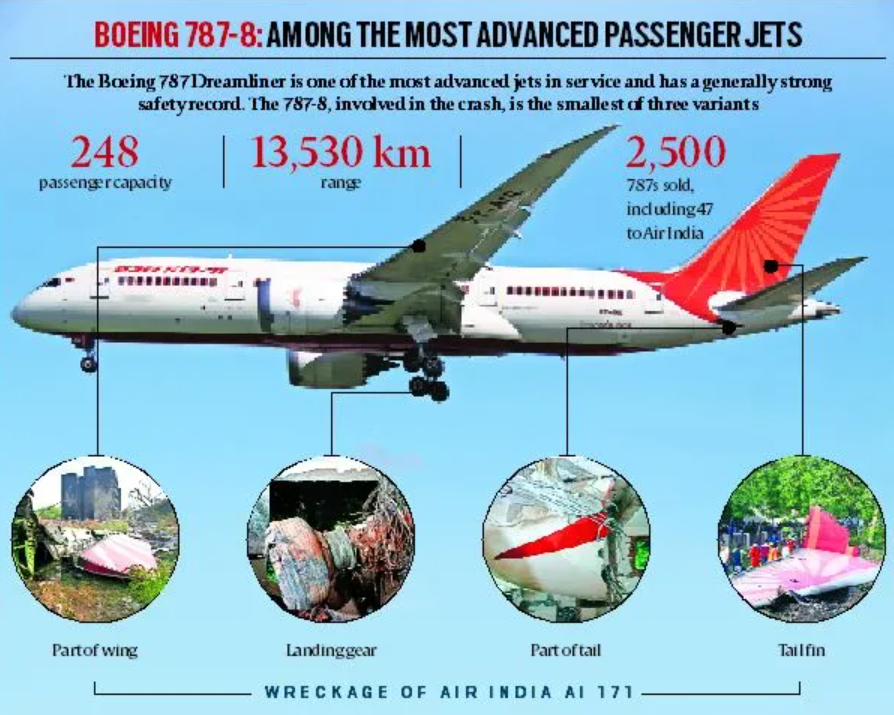Font size:
Print
Air India Crash
Ahmedabad Air India Crash: Why aircraft are most likely to meet with accidents during takeoffs, landings
Context: Flight AI171, an Air India Boeing 787-8 Dreamliner, flying from Ahmedabad to London Gatwick, crashed shortly after takeoff on Thursday (May 12) afternoon.

More on News
- The aircraft went down 1.5 km (0.9 miles) from the runway in Meghani Nagar, a densely populated residential area near Sardar Vallabhbhai Patel International Airport.
- 241 people onboard and several on the ground were killed, making it the first-ever fatal crash involving a 787-8 Dreamliner since its commercial debut in 2011.
- The sole survivor, speaking to Indian media, reported hearing a “loud bang” shortly after takeoff, and that the aircraft failed to climb properly. This aligns with the speculation of a mechanical failure or engine issue.
Potential Contributing Factors
- Engine Performance Issues: Several pilots and aviation experts have floated the possibility of a double engine failure, a very rare event (Could be caused by fuel contamination, fuel starvation, or even bird ingestion). In such a scenario, the Ram Air Turbine (RAT), a backup device that provides emergency power, might have deployed.
- Bird Strikes: Ahmedabad airport is known for bird activity, with 462 bird strikes reported across Gujarat in five years, most at this airport. 38 bird strikes were reported in Ahmedabad in 2022–23 alone — a 35% rise from the year prior. A bird strike severe enough to cause loss of power in both engines is rare, but not impossible.
- Flap Configuration: Some experts raised the possibility that the aircraft’s flaps were not extended during takeoff. Flaps are essential for generating lift at lower speeds, especially during hot weather and full-load conditions.
- Ahmedabad was near 40°C (104°F) at the time, increasing the takeoff difficulty due to thinner air. Without proper flap deployment, the aircraft might have been unable to climb, leading to a stall.
When Do Most Aviation Accidents Occur?
- According to the International Air Transport Association (IATA):
- Over the period from 2005 to 2023, more than 53% of aviation accidents occurred during the landing phase.
- The takeoff phase accounted for 8.5%, with initial climb (immediately after takeoff) and final approach (just before landing) responsible for another 6.1% and 8.5%, respectively. Rejected takeoffs made up 1.8% of accidents.
- Boeing’s data on fatal commercial jet accidents (2015–2024) presents a similar pattern. Despite making up just 2% of flight exposure, takeoff and initial climb contributed to 20% of accidents and 20% of fatalities.
- The climb phase accounted for 10% of fatal accidents and 35% of fatalities, even though it represented only 14% of total flight time (exposure).
- Meanwhile, final approach and landing accounted for 47% of accidents and 37% of fatalities, though they made up only 4% of exposure.
- By contrast, the cruise phase, which comprises 57% of a typical 1.5-hour flight, accounted for just 10% of fatal accidents and less than 0.5% of fatalities.
Why Takeoff and Landing Are Riskiest?
- The start and end of a flight carry the highest risk. This is largely because aircraft are “low and slow” during these periods — low in altitude and slower in speed — which significantly reduces the margin for error. At cruise altitude (e.g., 36,000 ft), even with engine failure, planes glide safely, giving pilots 8+ minutes to respond.
- Other factors include:
- Engine stress during takeoff, when the aircraft is heaviest and must overcome gravity.
- Wing stalls are caused by exceeding the critical angle of attack — especially dangerous during takeoff.
- Environmental threats like bird strikes, turbulence, and poor weather are more prevalent at lower altitudes.
- The complexity of landing, where pilots must manage multiple real-time variables — wind speed, direction, aircraft weight, angle of descent — all while preparing to land within a precise window. Most landing accidents are due to pilot error.
How does aviation remain safe despite such events?
- Despite such high-profile accidents, flying remains the safest mode of travel. According to the International Civil Aviation Organisation (ICAO), the rate of commercial flight accidents has dropped from 4.9 per million departures in 2005 to 1.9 in 2023.
- Even though air crash fatalities can fluctuate from year to year — with events like the 2014 twin tragedies accounting for nearly 60% of that year’s 911 fatalities — the overall trend is downward.
- Safety improvements can be attributed to:
- Stronger aircraft designs and more reliable systems.
- Advanced pilot training, thanks to high-fidelity simulators.
- Real-time weather forecasting and better navigation systems.
- Enhanced safety protocols, some of which are relatively recent (e.g., banning smoking in aircraft cabins, which was only phased out in the 1990s).
Subscribe to our Youtube Channel for more Valuable Content – TheStudyias
Download the App to Subscribe to our Courses – Thestudyias
The Source’s Authority and Ownership of the Article is Claimed By THE STUDY IAS BY MANIKANT SINGH


